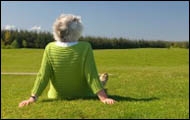
The report, "Older Americans 2010: Key Indicators of Well-Being," is a collaborative effort of 15 federal agencies who contributed data from 2007 and 2008, includes 37 key indicators that fall into one of five major categories: population, economics, health status, health risks and behaviors and health care. Aging and other demographic issues are among a dozen topics in development by State of the USA as part of its mission to enable Americans to track progress for themselves in the issues they care about the most. Among the reports findings:
- In 2008, there were an estimated 39 million people age 65 and over in the United States, accounting for just over 13 percent of the total population. The older population in 2030 is expected to be twice as large as in 2000, growing from 35 million to 72 million and representing nearly 20 percent of the total U.S. population.
- In 1965, 24 percent of the older population had graduated from high school, and only 5 percent had at least a bachelor's degree. By 2008, 77 percent were high school graduates or more, and 21 percent had a bachelor's degree or more.
- The number of men age 85 and over who are veterans is projected to increase from 400,000 in 2000 to almost 1.2 million by 2010. The proportion of men age 85 and over who are veterans is projected to increase from 33 percent in 2000 to 66 percent in 2010.
- Between 1974 and 2007, there was a decrease in the proportion of older people with income below poverty from 15 percent to 10 percent and with low-income from 35 percent to 26 percent; and an increase in the proportion of people with high income from 18 percent to 31 percent.
- In 2007, the median net worth of households headed by white people age 65 and over ($280,000) was six times that of older black households ($46,000). This difference is less than in 2003 when the median net worth of households headed by older white people was eight times higher than that of households headed by older black people.The large increase in net worth in past years may not continue into the future due to recent declines in housing values.
- Labor force participation rates have risen among all women age 55 and over during the past four decades. As new cohorts of baby boom women approach older ages they are participating in the labor force at higher rates than previous generations. Labor force participation rates among men age 55 and over have gradually begun to increase after a steady decline from the early 1960s to the mid-1990's.
- Life expectancy at age 65 in the United States is lower than that of many other industrialized nations. In 2005, women age 65 in Japan could expect to live on average 3.7 years longer than women in the United States. Among men, the difference was 1.3 years.
- The prevalence of certain chronic conditions differs by sex. Women report higher levels of arthritis (55 percent versus 42 percent) than men. Men report higher levels of heart disease (38 percent versus 27 percent) and cancer (24 percent versus 21 percent).
- Between 1992 and 2007, the age-adjusted proportion of people age 65 and over with a functional limitation declined from 49 percent to 42 percent.
- There was no significant change in the percentage of people age 65 and over reporting physical activity between 1997 and 2008.
- As with other age groups, the percentage of people age 65 and over who are obese has increased since 1988-1994. In 2007-2008, 32 percent of people age 65 and over were obese, compared with 22 percent in 1988-1994. However, over the past several years, the trend has leveled off, with no statistically significant change in obesity for older men or women between 1999-2000 and 2007-2008.
- The percentage of people age 65 and over living in counties that experienced poor air quality for any air pollutant decreased from 52 percent in 2000 to 36 percent in 2008.
- The proportion of leisure time that older Americans spent socializing and communicating--such as visiting friends or attending or hosting social events--declined with age. For Americans age 55-64, 13 percent of leisure time was spent socializing and communicating compared with 8 percent for those age 75 and over.
- After adjustment for inflation, health care costs increased significantly among older Americans from $9,224 in 1992 to $15,081 in 2006.
- From 1977 to 2006, the percentage of household income that people age 65 and over allocated to out-of-pocket spending for health care services increased among those in the poor/near poor income category from 12 percent to 28 percent.
- The number of Medicare beneficiaries enrolled in Part D prescription drug plans increased from 18.2 million (51 percent of beneficiaries) in June 2006 to 22.2 million (57 percent of beneficiaries) in December 2009. In December 2009, 61 percent of plan enrollees were in stand-alone plans and 39 percent were in Medicare Advantage plans. In addition, approximately 6.2 million beneficiaries were covered by the Retiree Drug Subsidy.
(Older Americans 2010: Key Indicators of Well-Being)
Suzette Lohmeyer is a staff writer and producer for State of the USA.